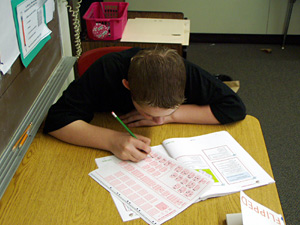Audio
Photos
Resources
| |||||||||||||||||||||||||||||||
June 29, 2005
 |
| Sixth grader Gabriel Ripley answered test questions at Como Park Elementary in St. Paul. (MPR Photo/Tim Pugmire) |
St. Paul, Minn. — The annual release of state test scores can generate a lot of anxiety. Under the federal No Child Left Behind Law, the results of those reading and math exams are used to determine whether schools are meeting yearly performance goals. Last year, 472 Minnesota schools were identified as falling short.
Sen. Steve Kelley, DFL-Hopkins, chairman of the Senate Education Committee, says the current accountability system is flawed.
"No Child Left Behind asks us to look at how did we do for third graders this year, and then compare that with the next group of third graders, who may be very different kids in a lot of ways," Kelley said.
Kelley would rather have a testing system that measures the academic growth of each student from grade to grade. The testing system he's pushing for is known as "value-added," because it can show the value schools and teachers are adding to student achievement.
"A value-added or a growth model asks the question, 'You know what the third graders did on the test, then how did the school help those third graders be better fourth graders? How much progress did those students make?'" said Kelley.
The value-added concept enjoys bipartisan support. Rep. Mark Buesgens, R-Jordan, chairman of the House Education Policy and Reform Committee, said he too wants more information on student progress over time. But Buesgens doesn't want that growth to outweigh the need for students to meet the proficiency levels of No Child Left Behind.
"It's kind of like the idea of a student coming out of the university and applying for a job in a hospital," Buesgens said. "And the hospital says, 'Look at your overall grades, you didn't pass half of your classes.' And the student says, 'Yeah, but you should have seen how well I improved from junior to senior year.' Well, OK fine, but you've got to meet the benchmarks."
Buesgens and Kelley said the data gathered from value-added tests could be use in conjunction with proposed reforms in teacher pay. This year's House and Senate education bills push school districts to pay teachers based on classroom performance, rather than years of service.
Most Minnesota school districts are already using some form of value-added testing. In St. Paul, the Stanford Achievement Test 10th Edition provides the additional data district officials say they need for a more complete picture of student achievement.
Tom Watkins, the St. Paul district's director of research, evaluation and accountability, said the exams are an important tool in tracking student growth. But he's concerned about drawing too many conclusions about the value schools and teachers are adding to the process.
"If it's used the wrong way it can be disastrous for an educational system," Watkins said. "Because it's really not giving people credit for the good things that they did, and in some cases giving punishment for those cases where they didn't deserve it. So, it has huge consequences."
The House and Senate education bills direct Minnesota's education commissioner to implement value-added assessments by selecting a group of schools to participate in a trial program. One sticking point between the two bills is the Senate's requirement to use new computer-based tests, rather than pencil-and-paper exams.






